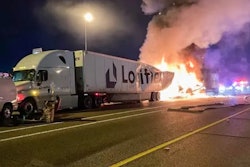In the early morning of Wednesday, July 12, a Greyhound bus traveling west on I-70 struck three tractor trailers parked on the offramp near the Silver Lake rest area in Highland, Illinois.
The crash tragically killed three passengers on the Greyhound and injured 14 more. None of the three truck occupants were injured.
That same day, a team from the National Transportation Safety Board arrived to investigate the crash, but to many in trucking, the story sounds all too familiar.
The Truckload Carriers Association called the crash just one of the many "deadly consequences of the truck parking shortage."
[Related: Truck parking reimagined: Bennett's 'Large car campgrounds']
"While the trucks shouldn’t have been parked there, they likely had nowhere else to go," TCA wrote about the crash. "This avoidable crash emphasizes the importance of adequate truck parking. Truckers are often forced to park illegally along highway shoulders and entry/exit ramps," putting themselves and other drivers at risk.
But there's billions of dollars in federal and state money available for truck parking projects and precious few actual new spots being built.
The solution to this, according to TCA Senior Vice President of Safety and Government Affairs David Heller, must include the truck parking bills currently in the House and Senate. Heller said that while previous infrastructure bills did include money that could be used for truck parking, those funds were discretionary.

"States and municipalities have to choose roads, bridges or truck parking, and truck parking always seems to fall into third place," said Heller. "That's why there's an additional need for this bill that's strictly for truck parking."
Heller spends much of his time making this case to Congress, and pointed to the truck parking bills' bipartisan support as a recent success, saying the truck parking crisis had become "basic knowledge" on Capitol Hill. Yet building more truck parking will take years, even if the bill passes.
And the bill itself is not perfect. Heller said even if the $755 million in funding for truck parking gets approved, there's "nothing in the bill about where, geographically," truck parking must be built.
[Related: The worst regions for truck parking]
Truck parking represents just one issue behind that grisly Greyhound crash. Longtime haulers often attribute the truck parking issues in part to the electronic-logging-device mandate, and a lack of flexibility within the hours of service. Unlike the truck parking crisis, the simple stroke of a pen might ease rigid HOS rules to allow drivers more flexibility to navigate unpredictable situations.
"They’re not wrong," Heller said of drivers who blame ELDs for the parking shortage. "It's no secret truck parking crisis became more of a reality since ELDs were put on every truck."
Heller said he frequently hears from drivers "stuck choosing between completing a trip and being legally and properly parked. It's a call they make on a daily basis. They say, 'One way or another I'm going to be cited for something, whether it's an HOS violation or being parked illegally.'"
Heller said TCA's efforts to lobby Washington have run in the same direction as driver challenges to the HOS. "Flexibility would go a long way," he said. "We don’t need 12-13 hours of driving a day, that's just not realistic and nobody wins that argument." He cited recent studies that say drivers mostly average just under seven hours of driving a day, anyway.
Instead, like owner-ops who have recently petitioned the FMCSA for more wiggle room, not just more hours, Heller is pushing for 5/5 or 6/4 sleeper splits, that "do give drivers more flexibility to deal with their day," he said.
[Related: 2020's split-sleeper change: FMCSA's greatest hit?]
There's no bill in Congress proposing that right now. TCA has focused it's advocacy around the $755 million for parking. An FMCSA study on detention time, however, promises to shed some light on the issue. Trucking should "probably have the results sometime in 2025," said Heller, who said it will be the first such study to "separate detention time and dwell time." Generally, dwell time refers to all time spent at a shipper or receiver facility, while detention time refers specifically to the amount of time spent waiting to get loaded or unloaded. Having a good read on detention, narrowly defined, could prove helpful in "laying the groundwork in the future for further flexibility in the hours of service," said Heller.
Heller sympathized with the driving public on the long timelines here, saying government work takes years and years, and that drivers "not knowing where they're going to rest their head at night" was an ongoing and dangerous problem.
TCA and even Congress may also soon hear from the NTSB, who will oversee the investigation of the crash in Illinois and has their eye on parking issues, at least in part. “Rest area safety is one of the issues that will be a part of this investigation,” Tom Chapman, an NTSB board member told the Associated Press. “Again, we don’t know enough to be able to say with certainty that that’s what occurred, but that’s certainly one of the issues that we’ll be looking at as part of our investigation.”
[Related: POLL -- Detention time since the ELD mandate ... has it improved?]











